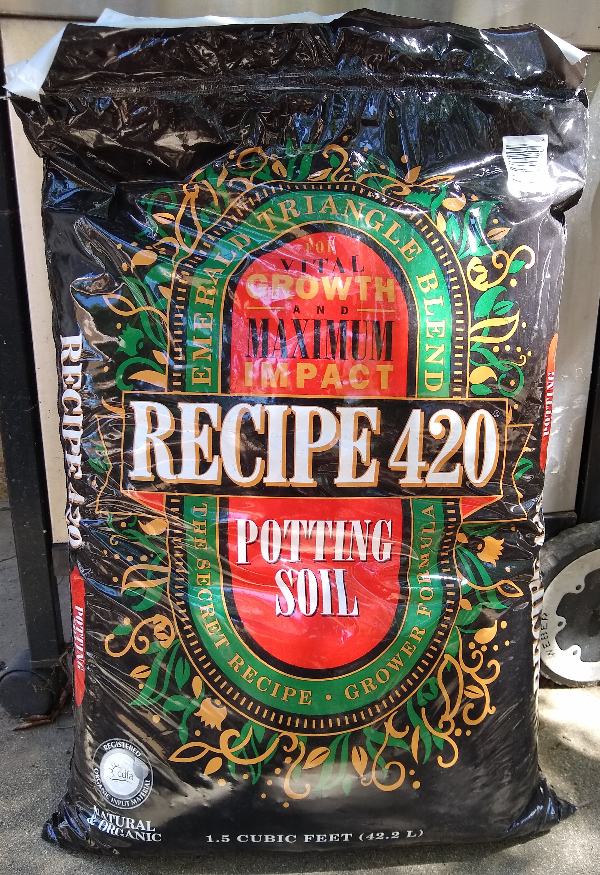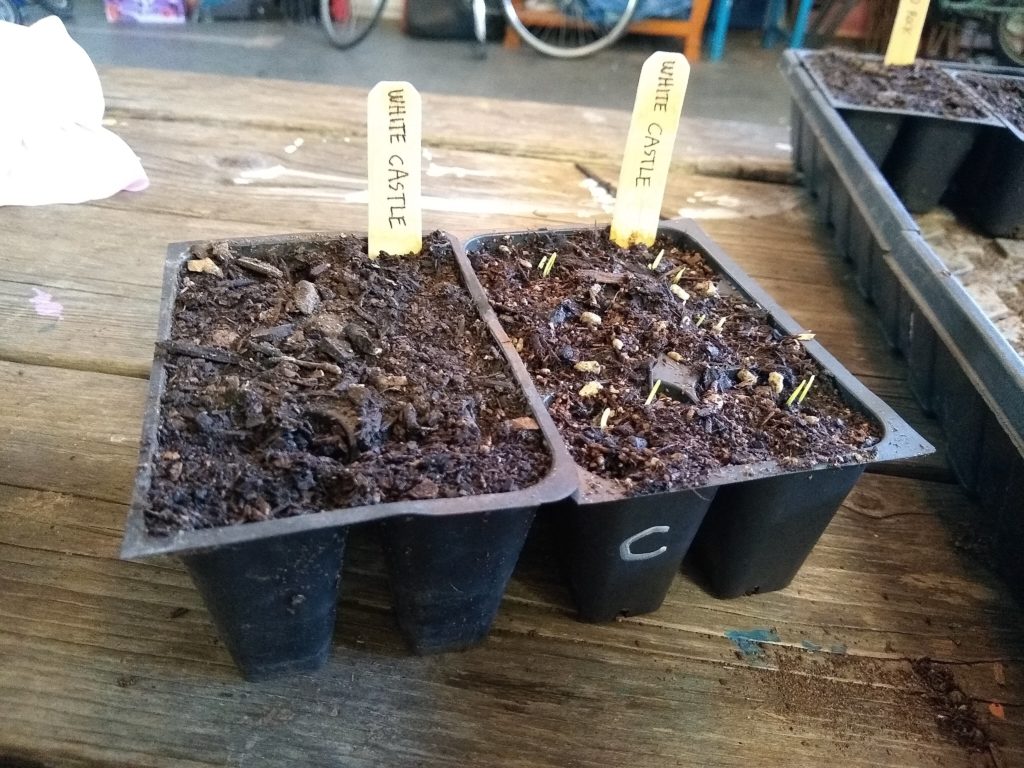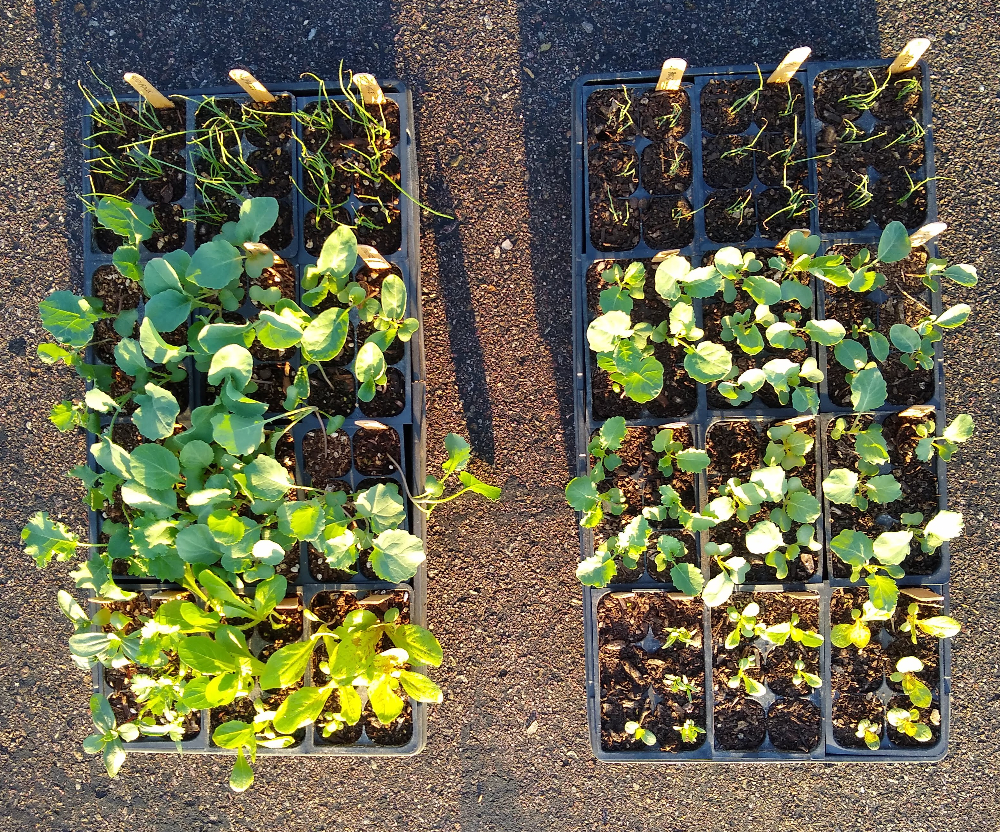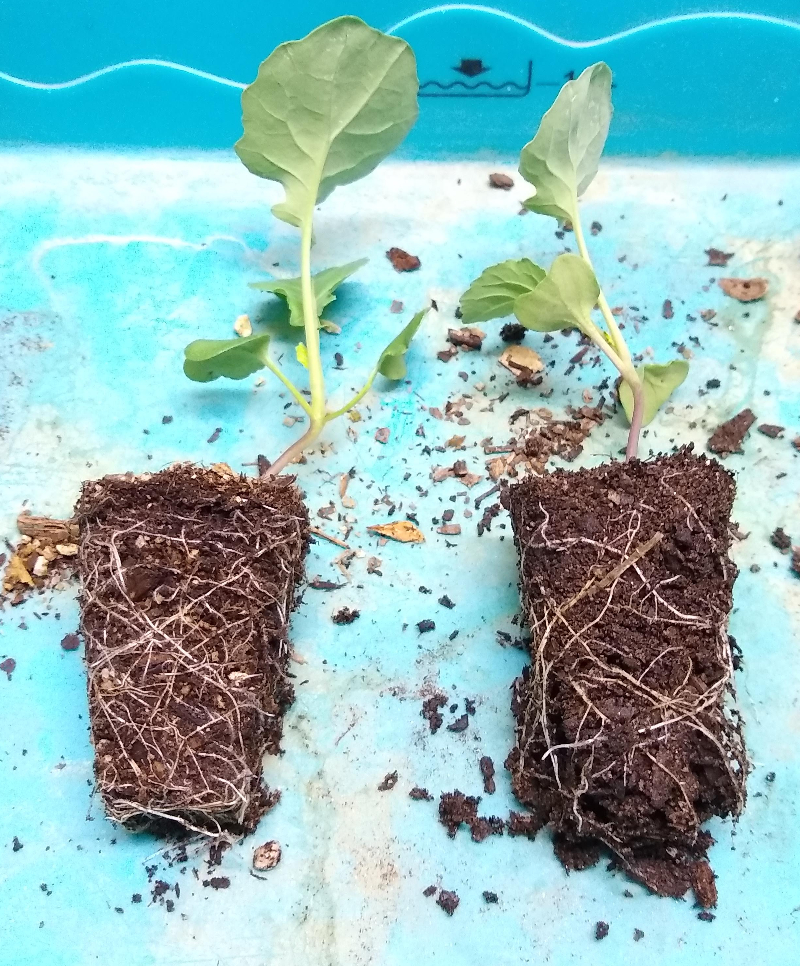Can I find a mix that grows vegetable starts better than my homemade compost?
For years, I’ve been growing my vegetable seedlings in compost that I make at home, but I’ve desired to discover whether another mix might work better. I want to grow the fastest, strongest vegetable plants.
So last month I started an experiment comparing my compost to the most expensive, most lauded potting soil on the West Coast. Recipe 420 Potting Soil is made by E.B. Stone up in Northern California. It cost me $17 for a single 1.5 cubic-foot bag of the mix purchased at a local nursery.
Here is the bag of Recipe 420:
Here is what the Recipe 420 mix looks like:
And here is what my compost looks like:
Comparing the two, my main impression was that my compost felt denser and heavier. The Recipe 420 product felt very light, full of air, and fluffy.
What are they made of?
The Recipe 420 label:
The label also says that a number of bacteria and fungi are added to the mix.
My compost is made of food scraps from our kitchen, garden scraps, wood chips, chicken manure, and a bit of dirt. It’s just stuff from our kitchen and yard, thrown into our chicken pen and mixed together and cool-composted over the course of a few months.
Starting the experiment
On September 14, I sowed a 72-cell tray with Recipe 420 and a 72-cell tray with my compost using exactly the same seeds. The seeds were onions (Red Rock, White Castle, Madalyn), kale (Winterbor), broccoli (Imperial), cabbage (Storage No.4), romanesco (Vitaverde), cauliflower (Snow Crown), collards (Top Bunch), lettuce (Coastal Star, Flashy Trout Back), zinnias, and cilantro.
I wanted to learn which mix got the seeds to germinate faster and which produced faster growth after germination. I was also looking for which mix made the healthiest looking seedlings (vibrant green leaves, no discoloration on the margins). And I would look for how large and broad the root systems were within each mix.
What do you predict?
Speeds of germination
By September 21 (one week from sowing), it became clear that the seeds of all types were germinating faster in the Recipe 420 mix. As you can see in the White Castle onion sets, most seeds in the Recipe 420 mix had germinated before even one seed in my compost had.
Rates of growth
Five days later, on September 26, most seeds in my compost had germinated and some were beginning to grow true leaves, but the plants in the Recipe 420 mix were almost all bigger than their counterparts in my compost.
Unfortunately, at about this time I lost some seedlings in the bottom row (lettuces, zinnias, and cilantro). It looked like an insect munched the emerging leaves, thereby killing the plants. And it happened mostly to the sets in my compost — the lower right section in the photo above. So from that point on, I disregarded the growth of those sets in my evaluations.
Experiment concluded
On October 5, some seedlings were large enough to be put in the garden ground so I took some final photos and made some final observations. All seedlings grown in Recipe 420 were bigger at this point.
How much bigger were the seedlings grown in Recipe 420? I estimated that they were a couple days to a week ahead, and this turns out to be about the difference in the dates of germination. My conclusion was that the plants grew at the same speed in both mixes, but because they got started earlier in Recipe 420 they ended up bigger.
How about the appearance of the plants? I saw no difference. Both looked a deep green with no discoloration on their leaves. They all appeared to be in vigorous health.
As for the root systems, as expected, the bigger (older) plants grown in Recipe 420 had more roots. But were the roots broader or better in any way? Not obviously, although this was hard to discern because the Recipe 420 mix contains white bits of pumice that are the same color as the roots, making the rootball seem whiter and fuller of roots.
Regardless, in the end, Recipe 420 performed better than my compost at starting vegetable seeds and growing them up to transplant size. Recipe 420 is the winner!
Cause of difference in germination speed
Now I was curious as to why Recipe 420 engendered faster germination. My guess is that the magic was in its lightness and fluffiness. Tiny vegetable seeds don’t have the strength to easily push up a heavy roof overhead when they are ready to grow.
How to improve my compost
To improve the speed at which vegetable seeds germinate in my compost, I should modify a few things. I should sow the seeds shallowly (make the “roof” thin), incorporate less dirt (which is heavy) into the mix, and incorporate more light materials such as leaves.
Further, when filling the cells with my compost, I should leave the mix fluffier; I have been in the habit of using my fingers to compact the compost down into each cell before sowing.
What’s next?
Since I’ve found a product that grows better vegetable starts than my homemade compost, why don’t I just abandon my compost and use the superior Recipe 420? I might. But I love to learn and discover so what I’m more inclined to do is tinker with my compost recipe to try to improve its efficacy.
As for you, if you don’t already have a vegetable seed-starting mix that you’re convinced is the best, I recommend trying E.B. Stone’s Recipe 420.
My previous seed-starting posts:
Experiment comparing composts for vegetable seed starting
Can you start vegetable seeds in compost?
Adding soil and compost to seed-starting mixes
All of my Yard Posts are HERE













Thanks for the experiment results! If you get the urge, it would be nice to know how the main brands of planting mix compare for starting seeds.
Exactly what I was thinking, Rick. I planned on testing GB Organics Blue Ribbon Blend. Which others should I include?
Great article, Greg! I love your passion to tinker and learn, then give us practical feedback. Keep up the great work.
Hi Greg, Dave from the Big Island again. I stopped using my own compost for seed starting because of Asian cockroaches infiltrating the compost. They are nocturnal and burrow in the compost during the day. They eat almost anything green and are impossible to control without using sevin.
So I now use Pro mix, with my own recipe for fertilizer which is equal parts blood meal. bone meal and greensand. I use 3 cups of the fertilizer to 10 gallons of pro mix. I also throw in a hand full of pelleted lime. I use the soil block technique made famous by Elliot Coleman. I also grow micro greens in straight pro mix then recycle the pro mix for later use. Works great!!
Also starting to harvest my Reed avocados
Thanks for your great posts.
Hi Dave,
Thanks for sharing. I’ve wanted to try soil blocks for so long but never gotten around to it. I think it’s the cost of the blocker tools that prevents me. Did you buy one or make one yourself? Hope the Reeds are tasting good; our season in most of California is about finished.
I would venture to guess the 420 mix (guano, kelp meal, fish bone meal). has more NPK than your mix. Keeping it light and airy would help with germination as well.
Hi Jim,
I had guessed that the 420 mix would be more nutrient dense than mine too, but I grew a couple tomatoes in each and found that the plants performed almost identically. I didn’t include that in the post above since the post was just about the performance of the mixes getting seeds up to transplant size. I also don’t conclude much from it because it was only literally two tomato plants. But it still surprised me.
I’m interested in doing a longer term experiment with 420 and another mix or two with multiple plants in containers.
Hi Greg,
I am looking forward to your new calendar— please add more on grafting citrus, stone fruits, avos and mangos. As well as composting, fruit tree maintenance
Hi Gil,
Thanks for the requests. I’ll add some more about those topics.
I would enjoy info on grafting avos, and the optimal size/developmental stage/best season for scion wood. Of course, more gorgeous photos!
Re: Compost. Worm castings seem to have an almost magical influence on seed germination. Seeds from apple cores germinating in my worm bin suggested germinating vegetable seeds right in the bin, which took place rapidly. Is it the fulvic acid, known to be excreted by earthworms? Certainly wouldn’t hurt, according to this article “The quality of compost was improved by low concentrations of fulvic acid owing to its optimization of the exceptional microbial structure.” https://www.sciencedirect.com/science/article/abs/pii/S0960852421011846
Thanks for sharing that, Randy. Sent me on a little learning journey. I now know more about fulvic acid — although it sounds like even soil scientists have a lot left to learn about it. You are inspiring me to start a worm bin too.
As you undoubtedly discovered, one can buy fulvic acid extracted from natural deposits, and I bought some. Does it make a difference? No idea! I read another article that indicated fulvic acid from worms was better.
But the worms’ secret isn’t clear to me. Worms eat living bacteria but they won’t eat a live plant. My worms, Europeans, I bought online. They’re fascinating and drink at least a cup a day from their water dish and LOVE microwaved, powdered eggshells. They eat cardboard, peat moss, coconut coir, stale bread, and, of course, vegetable trimmings. I started with a 5-gallon bucket. One tip: Bury their chow to avoid flies and mold, which they won’t eat. And don’t forget the free water. They love their water dish, which is for reptiles in a terrarium. They swim in it! Oh, they love avocado and will gather under a skin like it’s a Quonset hut.
Greg- Such a timely and relevant post! I’m in Sonoma and started a bunch of seeds directly in raised beds and have incorporated a lot of EB Stone Organic Compost into the top layer and so far germination is pretty good. I’m curious if you have tried the EB Stone Seed Starter mix? I was thinking to use it for cell trays in my greenhouse.
Hi Mariangela,
I have used E.B. Stone Seed Starter Mix. A few years ago, I did a little comparison with it: https://gregalder.com/yardposts/adding-soil-and-compost-to-seed-starting-mixes/
I did similar tests, and got the same result. I also tried to rejuvenate the old 420 from used smart pots…all because of the lightness it provides. That worked well.
Hi Laurie,
Did you rejuvenate the 420 mix with your own compost? Is that what worked? I like that idea.